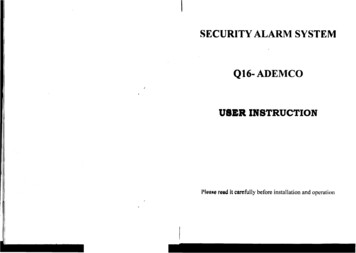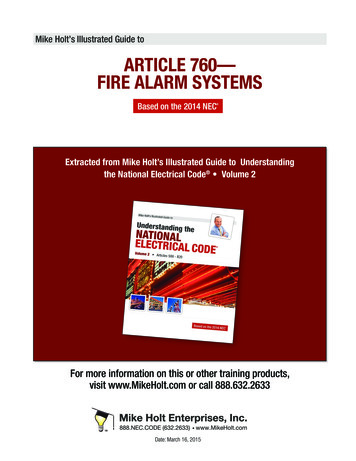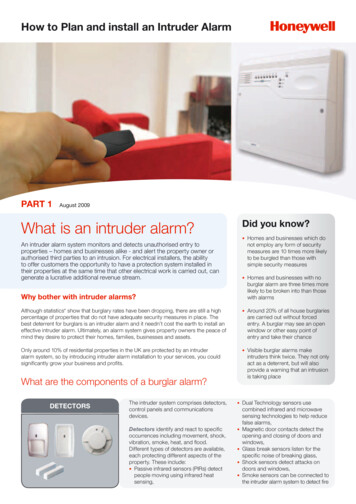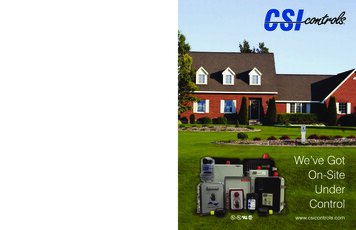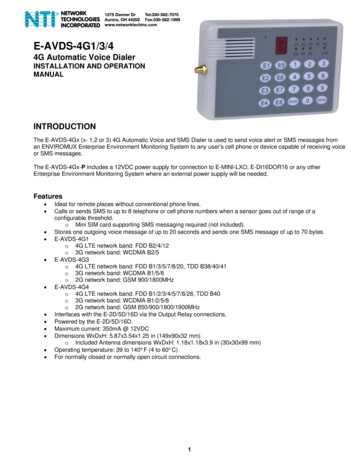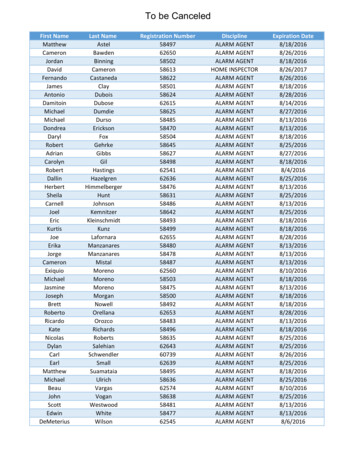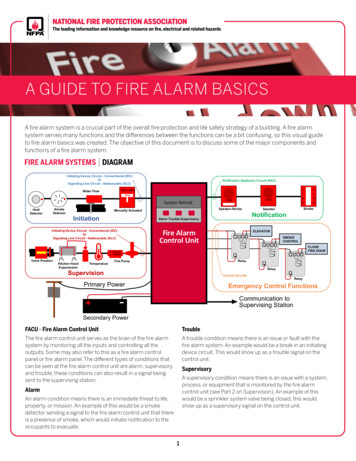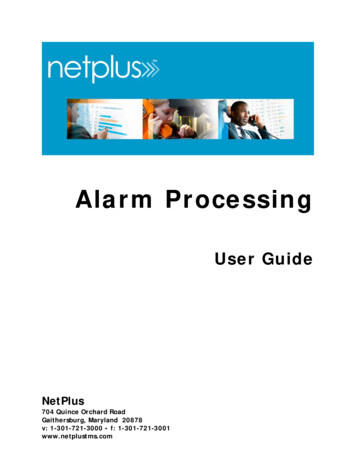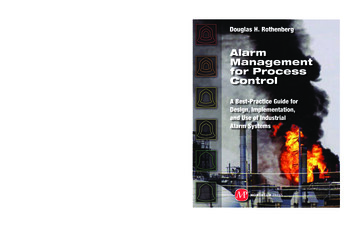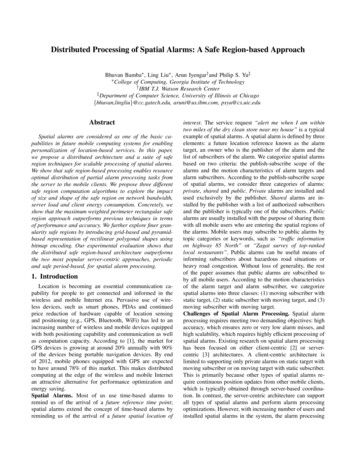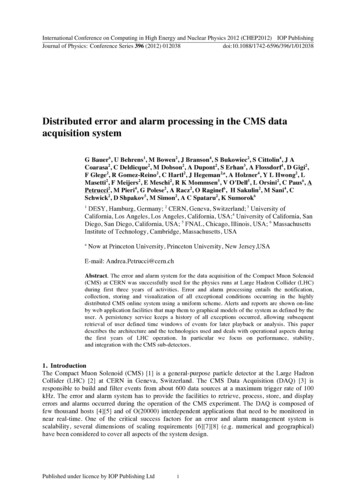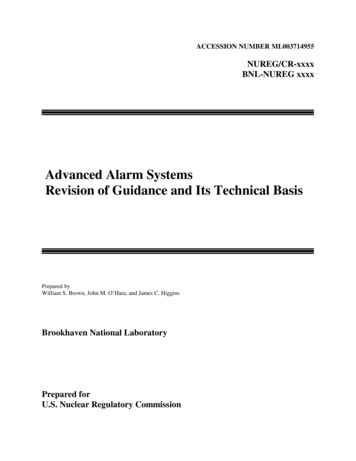
Transcription
ACCESSION NUMBER ML003714955NUREG/CR-xxxxBNL-NUREG xxxxAdvanced Alarm SystemsRevision of Guidance and Its Technical BasisPrepared byWilliam S. Brown, John M. O’Hara, and James C. HigginsBrookhaven National LaboratoryPrepared forU.S. Nuclear Regulatory Commission
NUREG/CRBNL-NUREGAdvanced Alarm Systems:Revision of Guidance and Its Technical BasisManuscript Completed:Date Published:Prepared byWilliam S. Brown, John M. O’Hara, and James C. HigginsBrookhaven National LaboratoryUpton, NY 11973-5000Prepared forOffice of Nuclear Regulatory ResearchU.S. Nuclear Regulatory CommissionWashington, DC 20555NRC JCN W-6290
ABSTRACTThe objective of this study was to update and revise Nuclear Regulatory Commission’s (NRC) guidance forreviewing alarm system design in the Human-System Interface Design Review Guideline (NUREG-0700, Revision1). The revisions were based on recent NRC research on the effects of alarm system design characteristics onoperator performance and on a study examining the introduction of new computer-based human-system interfacesystems into conventional nuclear power plants. In addition this present study examined research on alarm systemspublished since the NRC’s previous development of guidance for alarm systems, published in Human FactorsEngineering Guidance for the Review of Advanced Alarm Systems (NUREG/CR-6105). Specifically, wheresupported by the technical bases, changes were made to the alarm system characterization, HFE guidelines, and thepreviously identified human performance issues. While the characterization of alarm systems in NUREG/CR-6105did a reasonable job of representing their functional characteristics, it did not sufficiently address all aspects ofalarm systems that are important to a design review. Thus, the characterization was expanded to (1) better illustratethe relationship of the alarm system to the plant’s processes and systems, and (2) more clearly indicate therelationship between the human-system interface aspects of the alarm design and the guidance in NUREG-0700,Rev. 1. The research covered many aspects of alarm system design. Accordingly, modifications have been made inmost of the elements of the characterization. In general, the research provided confirmatory data that was used toclarify the guidelines. In addition, several new guidelines were developed and the criteria of some existingguidelines were modified or supplemented based on this recent research. Several human performance issues wereidentified in recent literature. In most cases, they reflect those previously identified in earlier phases of this project.This information was used to revise issues, where appropriate. The changes to the characterization and HFEguidelines discussed in this document were reviewed and will be incorporated into NUREG-0700, Revision 2.iiiNUREG/CR
NUREG/CRiv
TABLE OF CONTENTSPageABSTRACT . . . . . . . . . . . . . . . . . . . . . . . . . . . . . . . . . . . . . . . . . . . . . . . . . . . . . . . . . . . . . . . . . . . . . . . . . . . . . . . . iiiLIST OF FIGURES . . . . . . . . . . . . . . . . . . . . . . . . . . . . . . . . . . . . . . . . . . . . . . . . . . . . . . . . . . . . . . . . . . . . . . . . . viiEXECUTIVE SUMMARY . . . . . . . . . . . . . . . . . . . . . . . . . . . . . . . . . . . . . . . . . . . . . . . . . . . . . . . . . . . . . . . . . . . . ixPREFACE . . . . . . . . . . . . . . . . . . . . . . . . . . . . . . . . . . . . . . . . . . . . . . . . . . . . . . . . . . . . . . . . . . . . . . . . . . . . . . . . xiiiACRONYMS . . . . . . . . . . . . . . . . . . . . . . . . . . . . . . . . . . . . . . . . . . . . . . . . . . . . . . . . . . . . . . . . . . . . . . . . . . . . . . xv1INTRODUCTION . . . . . . . . . . . . . . . . . . . . . . . . . . . . . . . . . . . . . . . . . . . . . . . . . . . . . . . . . . . . . . . . . . . 1-12OBJECTIVE . . . . . . . . . . . . . . . . . . . . . . . . . . . . . . . . . . . . . . . . . . . . . . . . . . . . . . . . . . . . . . . . . . . . . . . 2-13METHODOLOGY . . . . . . . . . . . . . . . . . . . . . . . . . . . . . . . . . . . . . . . . . . . . . . . . . . . . . . . . . . . . . . . . . . 3-143.1Overview . . . . . . . . . . . . . . . . . . . . . . . . . . . . . . . . . . . . . . . . . . . . . . . . . . . . . . . . . . . . . . . . . . . 3-13.2Characterization of the Alarm System . . . . . . . . . . . . . . . . . . . . . . . . . . . . . . . . . . . . . . . . . . . . . 3-23.3Development of the Technical Basis . . . . . . . . . . . . . . . . . . . . . . . . . . . . . . . . . . . . . . . . . . . . . . 3-23.4Development of Guidelines and Documentation . . . . . . . . . . . . . . . . . . . . . . . . . . . . . . . . . . . . . 3-43.5Identification of Issues . . . . . . . . . . . . . . . . . . . . . . . . . . . . . . . . . . . . . . . . . . . . . . . . . . . . . . . . 3-53.6Peer Review . . . . . . . . . . . . . . . . . . . . . . . . . . . . . . . . . . . . . . . . . . . . . . . . . . . . . . . . . . . . . . . . . 3-5RESULTS . . . . . . . . . . . . . . . . . . . . . . . . . . . . . . . . . . . . . . . . . . . . . . . . . . . . . . . . . . . . . . . . . . . . . . . . . 4-14.1Basis for the Modifications to the Alarm System Characterization . . . . . . . . . . . . . . . . . . . . . . 4-14.1.14.1.24.2Evaluation of Recent Research: Descriptions of Alarm System Designs . . . . . . . . . . . 4-1Modifications to the Alarm System Characterization . . . . . . . . . . . . . . . . . . . . . . . . . . 4-8Guidelines for HFE Design Review . . . . . . . . . . . . . . . . . . . . . . . . . . . . . . . . . . . . . . . . . . . . . . 4-94.2.1General Guidelines . . . . . . . . . . . . . . . . . . . . . . . . . . . . . . . . . . . . . . . . . . . . . . . . . . . . 4-94.2.1.1 Evaluation of Recent Research . . . . . . . . . . . . . . . . . . . . . . . . . . . . . . . . . . . . 4-94.2.1.2 Modifications to General Guidelines for Alarm Systems . . . . . . . . . . . . . . . 4-114.2.2Alarm Definition . . . . . . . . . . . . . . . . . . . . . . . . . . . . . . . . . . . . . . . . . . . . . . . . . . . . . 4-124.2.2.1 Evaluation of Recent Research . . . . . . . . . . . . . . . . . . . . . . . . . . . . . . . . . . . 4-124.2.2.2 Modifications to Alarm Definition Guidelines . . . . . . . . . . . . . . . . . . . . . . . 4-144.2.3Alarm Processing and Reduction . . . . . . . . . . . . . . . . . . . . . . . . . . . . . . . . . . . . . . . . 4-144.2.3.1 Evaluation of Recent Research . . . . . . . . . . . . . . . . . . . . . . . . . . . . . . . . . . . 4-144.2.3.2 Modifications to Guidelines for Alarm Processing and Reduction . . . . . . . 4-16vNUREG/CR
4.2.4Prioritization and Availability of Alarms . . . . . . . . . . . . . . . . . . . . . . . . . . . . . . . . . . 4-174.2.4.1 Evaluation of Recent Research . . . . . . . . . . . . . . . . . . . . . . . . . . . . . . . . . . . 4-174.2.4.2 Modifications to Guidelines on Alarm Prioritization and Availability . . . . . 4-194.2.5Display . . . . . . . . . . . . . . . . . . . . . . . . . . . . . . . . . . . . . . . . . . . . . . . . . . . . . . . . . . . . 4-194.2.5.1 Visual Displays . . . . . . . . . . . . . . . . . . . . . . . . . . . . . . . . . . . . . . . . . . . . . . . 4-204.2.5.1.1 Evaluation of Recent Research . . . . . . . . . . . . . . . . . . . . . . . . . . . 4-204.2.5.1.2 Modifications to Visual Display Guidelines . . . . . . . . . . . . . . . . . 4-224.2.5.2 Auditory Signals . . . . . . . . . . . . . . . . . . . . . . . . . . . . . . . . . . . . . . . . . . . . . . 4-224.2.5.2.1 Evaluation of Recent Research . . . . . . . . . . . . . . . . . . . . . . . . . . . 4-234.2.5.2.2 Modifications to Guidelines for Auditory Signals . . . . . . . . . . . . . 4-264.2.6Control . . . . . . . . . . . . . . . . . . . . . . . . . . . . . . . . . . . . . . . . . . . . . . . . . . . . . . . . . . . . 4-274.2.6.1 Evaluation of Recent Research . . . . . . . . . . . . . . . . . . . . . . . . . . . . . . . . . . . 4-274.2.6.2 Modifications to Guidelines for Alarm Control . . . . . . . . . . . . . . . . . . . . . . 4-274.2.7Automated, Dynamic, and Modifiable Features . . . . . . . . . . . . . . . . . . . . . . . . . . . . . 4-284.2.8Reliability, Test, Maintenance, and Failure Indications . . . . . . . . . . . . . . . . . . . . . . . 4-284.2.9Alarm Response Procedures . . . . . . . . . . . . . . . . . . . . . . . . . . . . . . . . . . . . . . . . . . . . 4-294.2.9.1 Evaluation of Recent Research . . . . . . . . . . . . . . . . . . . . . . . . . . . . . . . . . . . 4-294.2.9.2 Modifications to Guidelines for Alarm Response Procedures . . . . . . . . . . . 4-294.2.10Control-Display Integration and Layout . . . . . . . . . . . . . . . . . . . . . . . . . . . . . . . . . . . 4-294.2.10.1 Evaluation of Recent Research . . . . . . . . . . . . . . . . . . . . . . . . . . . . . . . . . . . 4-294.2.10.2 Modifications to Guidelines for Control-Display Integration and Layout . . 4-304.3Human Performance Issues . . . . . . . . . . . . . . . . . . . . . . . . . . . . . . . . . . . . . . . . . . . . . . . . . . . . 4-305DISCUSSION . . . . . . . . . . . . . . . . . . . . . . . . . . . . . . . . . . . . . . . . . . . . . . . . . . . . . . . . . . . . . . . . . . . . . . 5-16REFERENCES . . . . . . . . . . . . . . . . . . . . . . . . . . . . . . . . . . . . . . . . . . . . . . . . . . . . . . . . . . . . . . . . . . . . . 6-1APPENDIX AAlarm System Characterization . . . . . . . . . . . . . . . . . . . . . . . . . . . . . . . . . . . . . . . . . . . . . . . . . A-1APPENDIX BAlarm System Guidelines . . . . . . . . . . . . . . . . . . . . . . . . . . . . . . . . . . . . . . . . . . . . . . . . . . . . . B-1APPENDIX CAlarm System Human Performance Issues . . . . . . . . . . . . . . . . . . . . . . . . . . . . . . . . . . . . . . . . C-1NUREG/CRvi
LIST OF FIGURES3.1Major steps in developing NUREG-0700 . . . . . . . . . . . . . . . . . . . . . . . . . . . . . . . . . . . . . . . . . . . . . . . . . 3-23.2Technical basis and process for developing guidance . . . . . . . . . . . . . . . . . . . . . . . . . . . . . . . . . . . . . . . . 3-33.3Example of an alarm system design review guideline . . . . . . . . . . . . . . . . . . . . . . . . . . . . . . . . . . . . . . . . 3-6viiNUREG/CR
NUREG/CRviii
EXECUTIVE SUMMARYThe alarm system is one of the primary means by which process abnormalities and failures are brought to plantpersonnel’s attention. The need to improve the human factors engineering (HFE) of alarm systems has led to thedevelopment of advanced, computer-based alarm systems. The goal of such systems is to assist the operator byprocessing alarm data, and to improve the presentation of this information. This technology promises to provide a meansof correcting many known deficiencies in alarm systems. Advanced, computer-based alarm systems are available asupgrades to existing human-system interfaces (HSIs), and are included in new control room designs.The U.S. Nuclear Regulatory Commission (NRC) reviews the HFE aspects of control rooms to ensure that their designmeets good human factors engineering principles and that the operator’s performance and reliability are appropriatelysupported to protect public health and safety. The Human-System Interface Design Review Guideline, NUREG-0700,Rev. 1, was developed to provide guidance on HFE for the NRC. The NRC staff uses NUREG-0700 for (1) reviewingsubmittals of HSI designs prepared by licensees or applicants for a license or design certification of a commercialnuclear power plant (NPP), and (2) undertaking HSI reviews that could be included in an inspection or other types ofregulatory review of HSI designs, or incidents involving human performance. It describes those aspects of the HSIdesign review process that are important to identifying and resolving human engineering discrepancies that couldadversely affect plant safety. NUREG-0700 also has detailed HFE guidelines for assessing the implementation of HSIdesigns.Alarm systems are key elements of control rooms because of the complexity of the process control task. Accordingly,NRC conducted a program of research aimed at developing a technical basis for reviewing advanced alarm systems.In an earlier NRC project, the key design features of advanced alarm systems were characterized, and HFE reviewguidance was developed and documented in Human Factors Engineering Guidance for Advanced Alarm Systems,NUREG/CR-6105. The guidance was based on a variety of sources, including HFE guidelines and standards, industryexperience, and literature on features of alarm system design and their effects on operator performance. The guidancewas subsequently integrated into Section 4 of NUREG-0700, Rev. 1.Since the publication of this guidance, there has been a considerable amount of research on alarm systems that may haveimplications for developing new guidance or for revising the existing guidance. The purpose of the study reported herewas to examine recent research and expand and revise the guidance to maintain it as state-of-the-art alarm system designreview guidance.Thus, the objective of this study was to review recent literature and, where supported by the technical bases in thatliterature, to address the following:1.Revise and expand the alarm characterization in NUREG/CR-6105.2.Revise and expand the HFE design review guidance:3. Develop new review guidance to address alarm system design characteristics, or human performance issuesnot fully covered in NUREG-0700, Rev. 1 Revise the existing review guidance for alarm designs in NUREG-0700, Rev. 1 Augment the technical basis of existing guidance with confirmatory informationIdentify human performance issues.The methodology used to accomplish these objectives was the general NUREG-0700 methodology for guidancedevelopment. The revisions to the characterization and guidance were based on recent NRC research on the effects ofalarm system design characteristics on operator performance and on a study examining the introduction of newcomputer-based human-system interface systems into conventional nuclear power plants. In addition we examinedixNUREG/CR
research on alarm systems published since the NRC’s previous development of guidance for alarm systems, publishedin NUREG/CR-6105.The results for each objective will be briefly summarized below.Alarm System CharacterizationA system characterization is important because it provided a structure within which the reviewer could requestinformation about a system and with which to structure the guidance. Existing alarm systems were reviewed andcompared with the alarm characterization previously developed in NUREG/CR-6105. While the characterizationreasonably represented the functional characteristics of alarm systems, it did not adequately address all aspects that areimportant to an HFE design review. Thus, the characterization was expanded to (1) better illustrate the relationship ofthe alarm system to the processes and systems of the plant, and (2) more clearly indicate the relationships between theHSI aspects of the alarm system and the guidance.HFE Design Review GuidelinesRecent research has addressed many aspects of alarm system design, and as a result, modifications were made to mostof the elements of the alarm system characterization. In general, the research yielded confirmatory data which could beused to further clarify the guidelines. In addition, where supported by the literature, new guidelines were developed.The guidelines were organized and specified in a standard format and were organized as follows: General GuidelinesAlarm DefinitionAlarm ProcessingAlarm Prioritization and Message AvailabilityDisplay- General Alarm Display Guidelines- Display of High-Priority Alarms- Display of Alarm Status- Display of Shared Alarms- Alarm Messages- Coding Methods- Display Layout and OrganizationUser-System Interaction- General Guidelines- Silence Functions- Acknowledge Functions- Reset Functions- Alarm Management- Automatic FeaturesControl DevicesBackup, Test, Maintenance, and Failure Indication Features- Reliability- Test- Maintenance- Failure IndicationAlarm Response ProceduresControl-Display Integration and LayoutThe guidance was then peer reviewed and revised. This new guidance will be integrated into NUREG-0700.NUREG/CRx
Human Performance IssuesWhere there was insufficient information for the technical basis upon which to develop valid design review guidance,an issue was defined. Several human performance issues were identified in recent literature. However, in most cases,they reflect ones already identified in earlier phases of this NRC project.The issues were organized into the following categories. General issues dealt with the overall purpose and design ofalarm systems, e.g., how to design alarm setpoints based on a two-stage alerted monitor approach to alarms. The secondcategory of alarms was related to processing methods, e.g., the relationship of processing complexity to operatorperformance and how to design more effective alarms to support secondary event detection. The third category ofalarms addressed display issues, e.g., formulating rules to allocate individual alarms to different types of alarm displays,such as messages or tiles. The fourth category of alarm issues dealt with controls, e.g., the determination of how toautomate various alarm functions.In conclusion, the studies reviewed have strengthened the alarm system design review guidance and its technicalbasis, especially for alarm processing and alarm availability. Three areas were especially reinforced. The first is thedesirability of alarm processing and its operational acceptability. The second is the importance of providing accessto suppressed alarms. The third is the need to provide information on the alarm’s reliability and information toenable operators to confirm the validity of alarms in the extremely complex and noisy control room.xiNUREG/CR
NUREG/CRxii
PREFACEBrookhaven National Laboratory (BNL) prepared this report for the Division of Systems Technology of the U.S.Nuclear Regulatory Commission’s (NRC’s) Office of Nuclear Regulatory Research as part of the requirements ofthe Advanced Alarm System Review Criteria project (FIN W-6290). Jerry Wachtel (301 415-6498; jxw4@nrc.gov)is the NRC’s Project Manager for this work. BNL’s Principal Investigator is John O’Hara (631 344-3638;ohara@bnl.gov).xiiiNUREG/CR
NUREG/CRxiv
DPIPSRTDSARTSDCVVDUAsea-Brown-Bovari-Combustion Engineeringadvanced boiling water reactorAlarm and Diagnosis - Integrated Operator SupportAtomic Energy of Canada, Limitedannunciation interrogation workstationadvanced PWR design (Westinghouse)advanced pressurized water reactoralarm response procedureCANDU Annunciation Message List SystemCanadian Deuterium UraniumCritical Parameter Indication and Alarm Systemcathode ray tubeElectricité de FranceHAlden Man-Machine LABoratoryhuman factors engineeringhuman-system interfaceinstrumentation and controlKorean Atomic Energy Research InstituteNordostchweizerische Kraftewerke AGNOkia Research Simulatornuclear power plantU.S. Nuclear Regulatory Commissionpiping and instrumentation diagramPlant Information Processing SystemResistance temperature detectorssilence, acknowledge, reset, and testspatially dedicated, continuously visible (display)video display unitxvNUREG/CR
NUREG/CRxvi
11 INTRODUCTIONThe alarm system is one of the primary means by which process abnormalities and failures are brought to plantpersonnel’s attention. The need to improve the human factors engineering (HFE) of alarm systems has led to thedevelopment of advanced, computer-based alarm systems. The goal of such systems is to assist the operator byprocessing alarm data, and to improve the presentation of this information. This technology promises to provide ameans of correcting many known deficiencies in alarm systems. Advanced, computer-based alarm systems areavailable as upgrades to existing human-system interfaces (HSIs), and are included in new control room designs.The U.S. Nuclear Regulatory Commission (NRC) reviews the HFE aspects of control rooms to ensure that theirdesign meets good human factors engineering principles and that the operator’s performance and reliability areappropriately supported to protect public health and safety. Alarm systems are key elements of control roomsbecause of the complexity of the process control task. Accordingly, NRC conducted a program of research aimed atdeveloping a technical basis for reviewing advanced alarm systems.In an earlier NRC project, the key design features of advanced alarm systems were characterized, and HFE reviewguidance was developed and documented in Human Factors Engineering Guidance for Advanced Alarm Systems,NUREG/CR-6105 (O’Hara, Brown, Higgins, and Stubler, 1994). The guidance was based on a variety of sources,including HFE guidelines and standards, industry experience, and literature on features of alarm system design andtheir effects on operator performance (see Section 3.1 of the present report for a detailed discussion of guidancedevelopment). The guidance was subsequently integrated into Section 4 of The Human-System Interface DesignReview Guideline, NUREG-0700, Rev. 1 (O’Hara et al., 1996).Since the publication of this guidance, there has been a considerable amount of research on alarm systems that mayhave implications for developing new guidance or revising it. The new literature can be divided into threecategories: NRC research, industry research, and general research on supervisory control.Two recent studies by the NRC are relevant to alarm systems. The first, conducted in an earlier phase of thisproject, specifically addressed the characteristics of alarm systems. During the development of the alarm systemguidance discussed above, several human performance issues were identified. These were areas in which data werelacking, or where findings conflicted. The issues were prioritized, and from this analysis, those associated with thevisual display of alarm information and simple alarm processing prioritization and filtering methods were rated ashaving the highest priority. To address this need, regulatory research was conducted on these issues (O’Hara,Brown, Hallbert, Skrånning, Persensky, and Wachtel, 2000).The primary purpose of the research, referred to in this report as the NRC alarm study, was to evaluate the impact ofthe alarm system design on the performance of the plant and on operators understanding of the potential safetyissues, and to provide data from which to develop design review guidance. Three alarm system designcharacteristics were studied: (1) alarm processing (degree of alarm reduction); (2) alarm availability (dynamicprioritization and suppression); and (3) alarm display (a dedicated tile format, a mixed tile and message list format,and a format in which alarm information is integrated into the process displays). The alarm characteristics werecombined into eight separate experimental conditions. Six two-person crews of professional nuclear power plant(NPP) operators participated in the study. Following training, each crew completed 16 test trials, two trials in eachof the eight experimental conditions (one with a low-complexity scenario, and one with a high-complexity scenario).Measures were obtained of plant performance, operator task performance, situation awareness, and workload. Inaddition, the operators’ ratings and evaluations were obtained.A second NRC study on alarm systems assessed the impact of introducing advanced HSI technologies into thecontrol room of a conventional nuclear power plant (Roth and O’Hara, 1998). This technology included anadvanced alarm system as well as computer-based procedures and an advanced display system. The study exploredthe effect of the new systems on the cognitive functioning of individual crew members, and on the structure andfunctioning of the crew as a team. The latter information was obtained by observing five crews of professional1-1NUREG/CR
1INTRODUCTIONoperators during full-scope training simulations of plant disturbances. In addition, operators and otherknowledgeable utility and vendor personnel were interviewed.The results of both studies have many implications for existing guidance. Within the context of NUREG-0700,regulatory research can play two important roles in establishing guidance: developing its technical basis, andconfirming the guidance (O’Hara, Brown, and Nasta, 1996). First, when the technical basis does not exist in othersource materials, the experimental results can fill the knowledge gap, i.e., provide the information upon whichdesign review guidance can be developed. Second, when the guidance has been based on other sources ofinformation, such as technical papers, testing may be necessary to gain confirmatory evidence that (1) the guidanceis an acceptable extraction, synthesis, or interpretation of the data, and (2) that the guidance is appropriate to anNPP application. Confirmatory research is most important for new guidance that was not developed from alreadyexisting guidelines. The NRC alarm study served both purposes: to evaluate the effects of specific alarm systemcharacteristics on performance to establish a technical basis upon which to develop design review guidance; and, toauthenticate the selected alarm system guidance.A second source of information stems from continuing research on alarm system concepts by the nuclear and othercomplex systems industries (such as process control and aviation). This work reflects both the increasingtechnological capabilities to address alarm system issues, and their widely recognized importance in effectiveprocess control. Up-to-date information on the work of alarm system designers in both U.S. industries and researchorganizations and those overseas has been published in the proceedings of several conferences (e.g., the“Specialists’ Meeting on Experience and Improvements in Advanced Alarm Annunciation Systems in NuclearPower Plants” sponsored by the International Atomic Energy Agency held in Chalk River, Canada, October 1996).The papers on plant alarm systems typically describe new (or enhanced) systems or approaches that offer bettersupport for operator actions, or cover specific shortcomings of existing approaches. A subset of these papers alsoreport the results of evaluations of the systems’ performance.Finally, there has been an increasing interest in supervisory control performance and in the design and effectivenessof alarm systems, and a significant number of papers on these topics have appeared in the general HFE literature,e.g., the special issue of Ergonomics (1995, Vol. 38) on Warnings in Research and Practice. The implications ofthe findings on alarm guidance from these three areas are the subject of this report.NUREG/CR1-2
1-3NUREG/CR
12 OBJECTIVEThe objective of this study was to review recent literature and, where supported by the technical bases in thatliterature, to address the following:1.Revise and expand the alarm characterization in NUREG/CR-6105.2.Revise and expand the HFE design review guidance: Develop new review guidance to address alarm system design characteristics, or human performance issuesnot fully covered in NUREG-0700, Rev 1 Revise the existing review guidance for alarm designs in NUREG-0700, Rev. 1 Augment the technical basis of existing guidance with confirmatory information13. Identify human performance issues.2-1NUREG/CR
NUREG/CR2-2
3 METHODOLOGYThe methodology used in this study is an application of the general NUREG-0700 methodology for guidancedevelopment (O’Hara, Brown, and Nasta, 1996). In this section, the general methodology is described including itsapplication in this study.3.1OverviewThis section describes the rationale for guidance development. Figure 3.1 shows the methodology for the overallguidance development for NUREG-0700. The portion of the methodology discussed in this report is boxed in thefigure.Scope of Research in This ProjectHSICharacterizationand Analysis ofGuidance NeedsDevelopment ofGuidanceDevelopment ofTechnical BasisPeerReviewIdentification ofUnresolvedIssuesIntegration ofGuidance intoDraftNUREG-0700Figure 3.1 Major steps in developing NUREG-0700 guidanceThe methodology was guided by the following objectives: Establish a process that will result in valid, technically defensible review criteria. Establish a generalizable process that can be applied to any aspect of HSI technology for which reviewguidance is needed. Establish a process that optimally uses available resources, i.e., develop a cost-effective methodology.The methodology places a high priority on establishing the validity of the guidelines. Validity is defined along twodimensions: internal and external validity. Internal validity is the degree to which the individual guidelines arebased on an auditable technical basis. The technical basis is the information upon which the guideline is establishedand justified. The technical bases vary for individual guidelines. Some guidelines may be based on technicalconclusions from a study of empirical research, some on a consensus of existing standards, while others are basedon judgement that a guideline represents good practices based on the information reviewed. Maintaining an audittrail from each guideline to its technical basis serves several purposes by enabling the following: Technical merit of the guideline to be evaluated by others A more informed application of the guideline since its basis is available to users Deviations or exceptions to the guideline to be evaluated3-1NUREG/CR
3METHODOLOGYExternal validity is the degree to which the guidelines are independently peer reviewed. Peer review is a goodmethod of screening guidelines for conformance to accepted HFE practices and for comparing guidelines to thepractical operational experience
basis, especially for alarm processing and alarm availability. Three areas were especially reinforced. The first is the desirability of alarm processing and its operational acceptability. The second is the importance of providing access to suppressed alarms. The third is the need to provide information on the alarm's reliability and .
